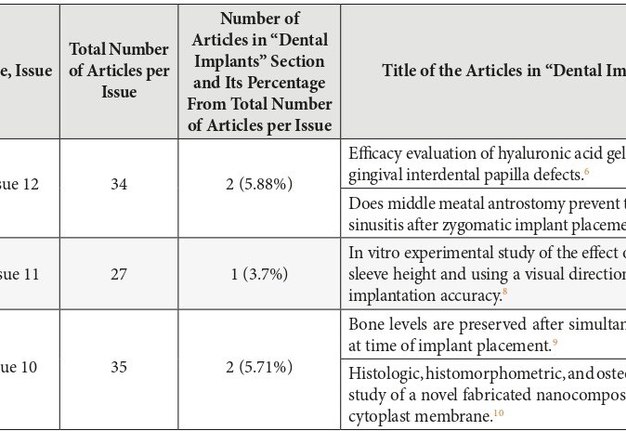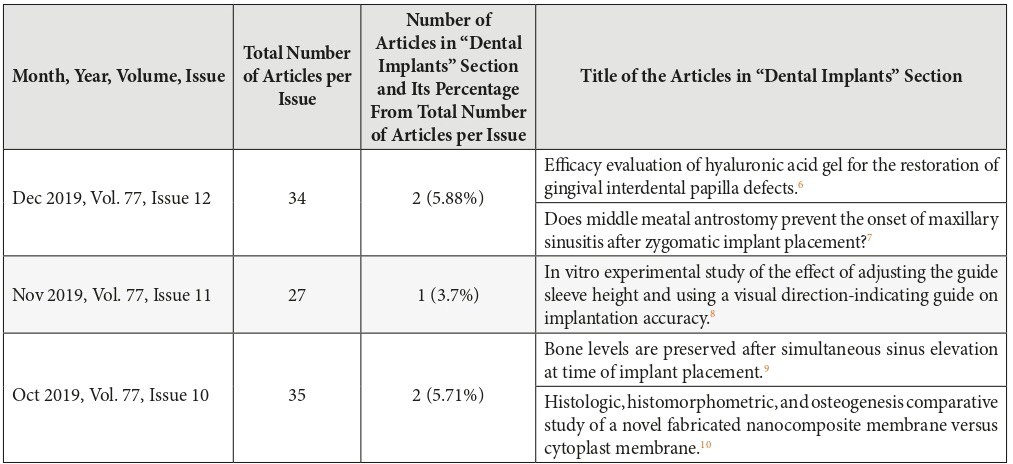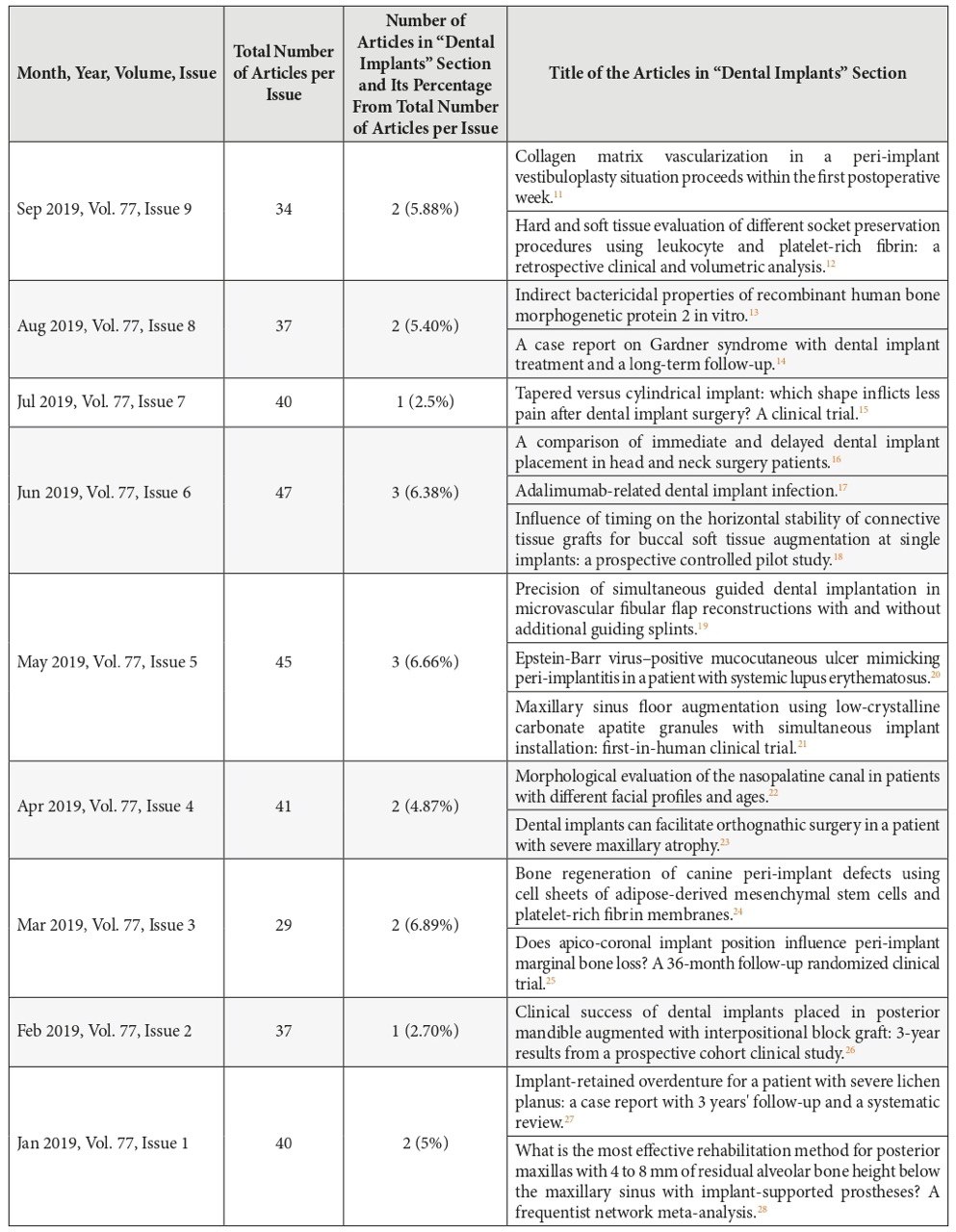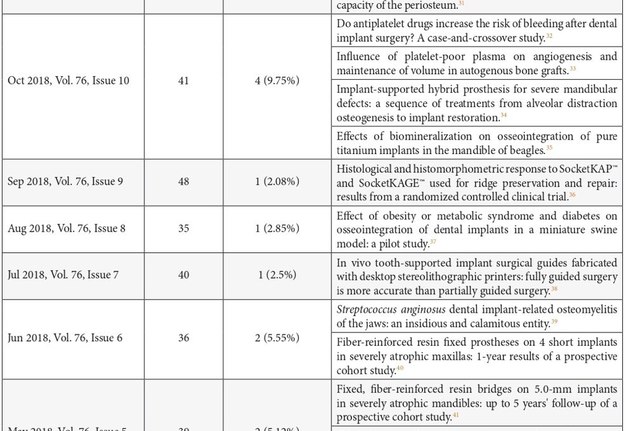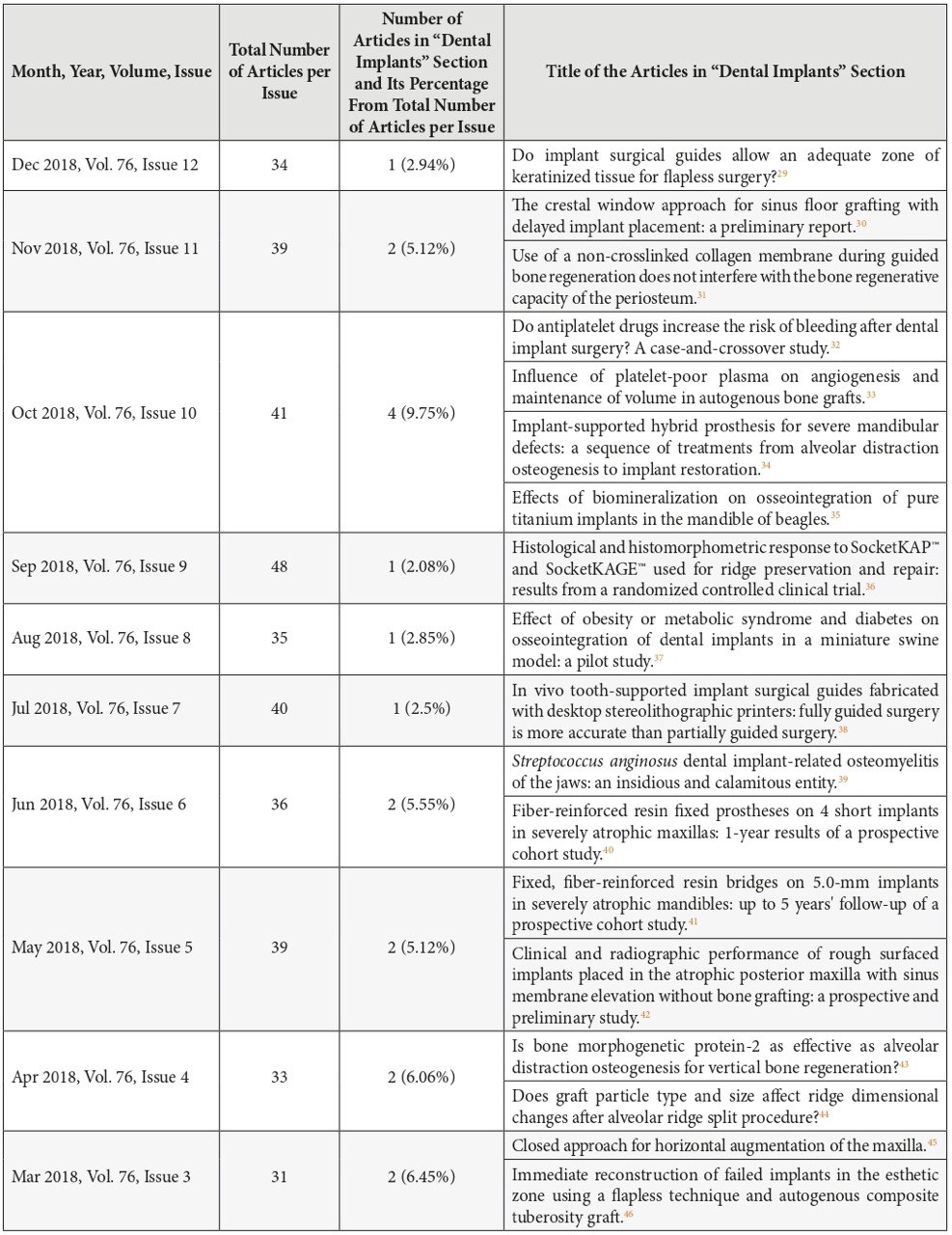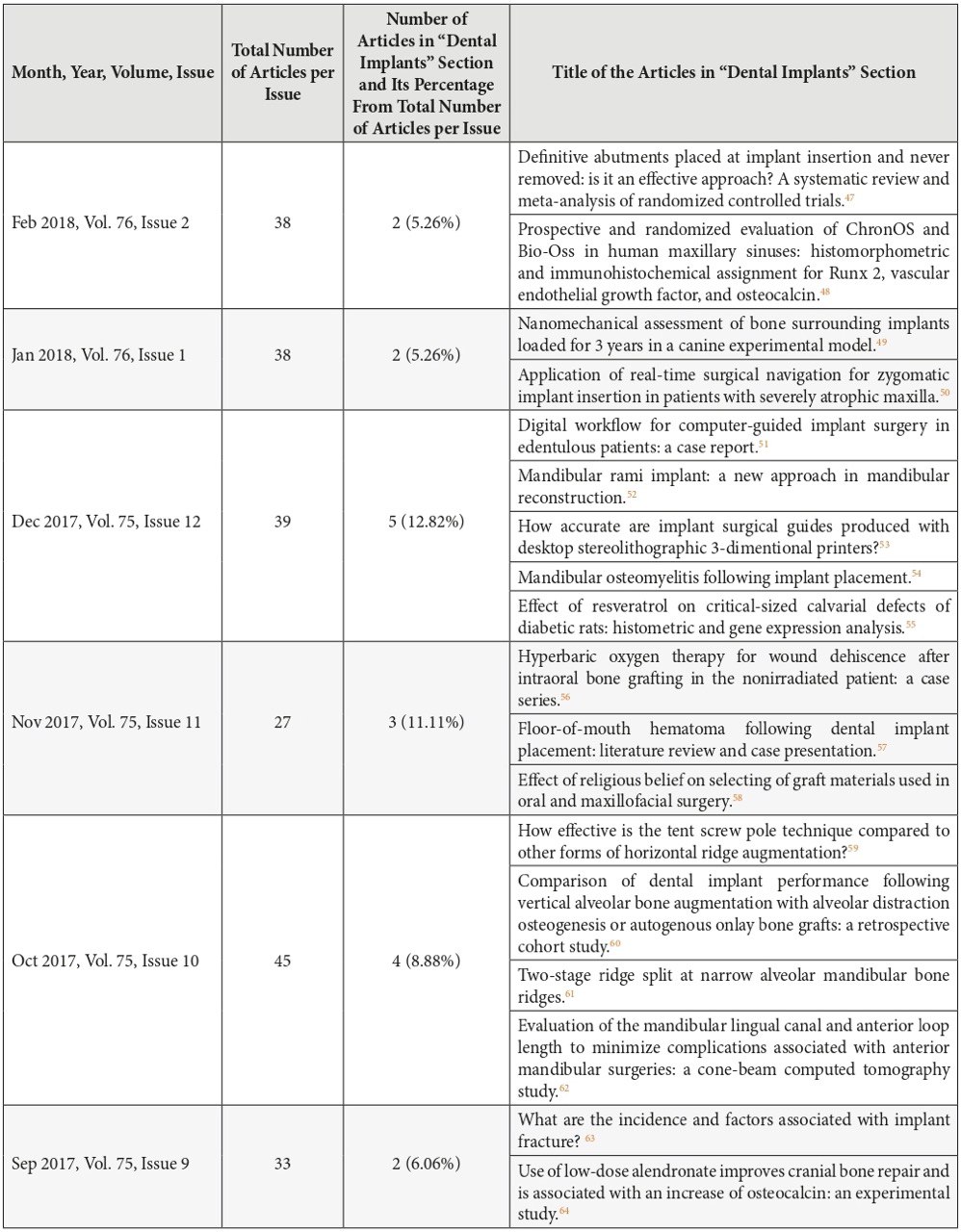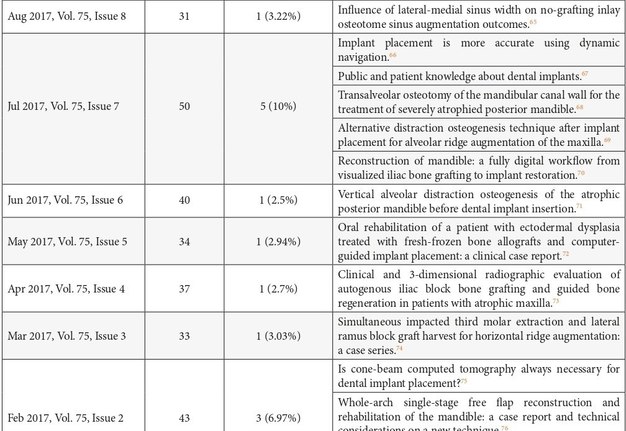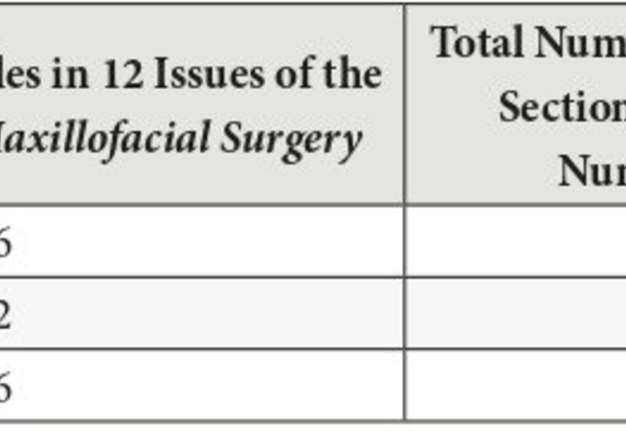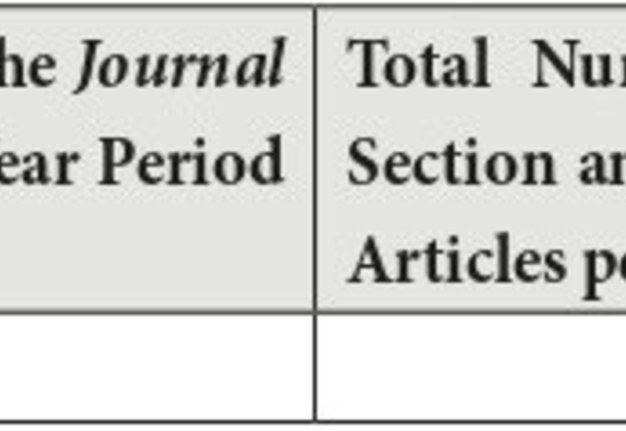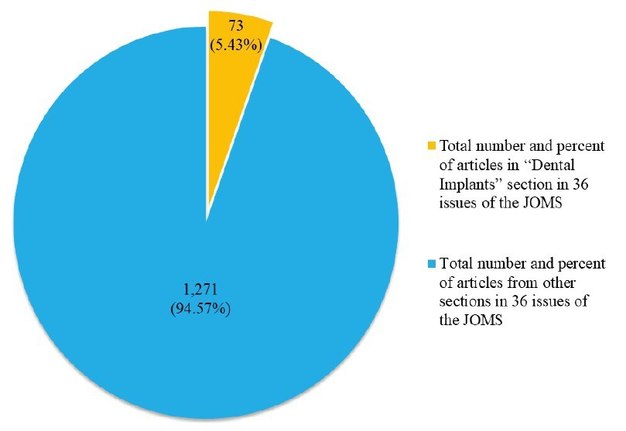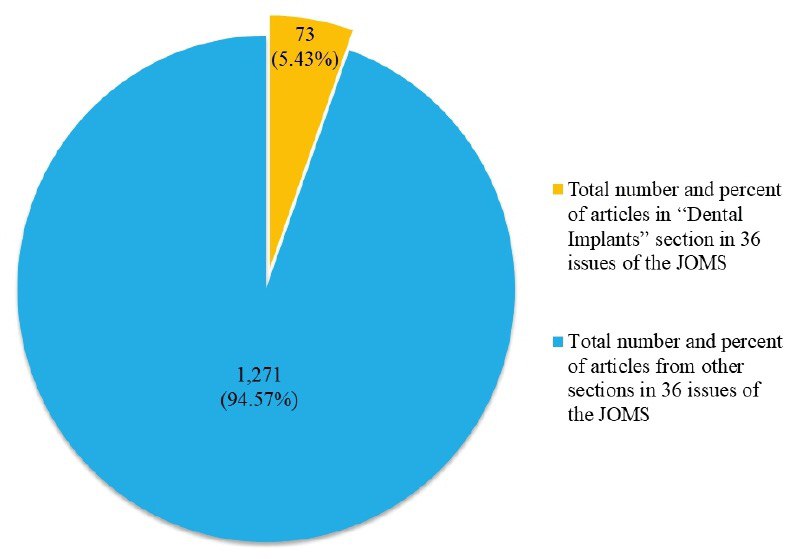Share of Articles in the “Dental Implants” Section among the Total Number of Articles in the Journal Focused on All Aspects of Oral and Maxillofacial Surgery and 5-Year Impact Factor 1.943: A 3-Year Longitudinal Bibliometric Analysis
February 28, 2020
https://doi.org/10.23999/j.dtomp.2020.2.3
J Diagn Treat Oral Maxillofac Pathol 2020;4:25−37.
Under a Creative Commons license
HOW TO CITE THIS ARTICLE
Nagorniak IV, Al-Makhamid NS. Share of articles in the “dental implants” section among the total number of articles in the journal focused on all aspects of oral and maxillofacial surgery and 5-year impact factor 1.943: a 3-year longitudinal bibliometric analysis. J Diagn Treat Oral Maxillofac Pathol 2020;4(2):25–37.
Contents: Summary | Introduction | Materials and Methods | Results | Conclusions | Role of Co-Authors | Fundings | Acknowledgments | References (79)
Summary
Purpose: To analyze the share of articles (total number and percent) in the “Dental Implants” section and the total number of articles during a 3-year period of publishing in the journal which had the highest total number of dental implant articles in the 1966-2016 period among other journals focused on all aspects of oral and maxillofacial surgery.
Materials and Methods: Our study included the calculations in the consecutive 36 issues (from January 2017 to December 2019) of the Journal of Oral and Maxillofacial Surgery (JOMS): 1) the total number of articles and 2) the number of articles in the “Dental Implant” section.
Results: Articles focused on pre-implant and implant surgery continue to stay in the focus of interest of the leading OMS journal reaching 5.43% (2.02 papers per 1 issue) of its total amount of publications. The mean total number of articles per 1 issue during a 3-year period became 37.33 papers. Despite the fact that the total number of articles in 2018 increased to 452, the number in 2017 and 2019 was mirrored and totaled 446 articles.
Conclusions: The articles focused on implantology continue to stay in the focus of interest of the leading OMS journal. The very high total number of articles (446) per year in 2017 and 2018 can indicate a very strong journal`s reputation among authors and submission levels. Also, as the mean of total number of articles per 1 issue is 37.33; it gives a possibility to increase the publishing frequency in two times (biweekly journal) what can lead to the multiple advantages for the authors, readers, and editorial office.
INTRODUCTION
Choosing of peer-reviewed journal for the publication is usually a challenge for the oral and maxillofacial surgeons, PhD students, residents, interns, and trainees of the fellowship programs. An academic system in different countries usually requires from authors to submit their papers to the journals covered by Scopus or publications with impact factor. For specialists who are involved into oral and maxillofacial surgery (OMS) with often performance of dental implants surgeries and persons in OMS educational programs the focus of attention usually falls to the journals with a scope on all aspects of OMS. Moreover, they want to publish their dental implants studies not only in the journals covered by Scopus and with impact factor, but simultaneously belonging to the OMS community and their specialty.
According to the study of Yeung and Leung (2018) the highest number of publications dedicated to dental implants among journals focused on all aspects of OMS was in the Journal of Oral and Maxillofacial Surgery (JOMS) and reached the number of 378 articles (i.e., for 2.6% of total articles [related with dental implants] count) from 1966 to 2016 period.1 The authors used the Web of Science Core Collection database and search for the topic of “dent* implant*.”1
The purpose of our study was to analyze the share of articles (total number and percent) in the “Dental Implants” section and the total number of articles during a 3-year period of publishing in the journal which had the highest total number of dental implant articles in a 1966-2016 period among other journals focused on all aspects of oral and maxillofacial surgery. The goal of analysis was to understand the publishing tendency in the “Dental Implants” section due to the next criteria: 1) reduction/growth of total number of published articles for three consecutive years (2017, 2018, and 2019), 2) percentage change of articles` number in the “Dental Implants” section.
MATERIALS AND METHODS
Despite the fact that two publications which are focused on all aspects of oral and maxillofacial surgery, Journal of Oral and Maxillofacial Surgery (JOMS) (2018 impact factor = 1.781)2 and International Journal of Oral and Maxillofacial Surgery (IJOMS) (2018 impact factor = 1.961)3, are included to the 10 journals with the highest number of dental implant publications,1 and despite the fact that the 2018 and 5-year impact factor of IJOMS4 is higher than that of JOMS5 the last one was chosen as object of the study due to the fact that it contains 35.98% higher total number of dental implant articles (Table 1) in a 1966-2016 period.1 Thus, taking into account the statistics of Yeung and Leung, as of march 2018, the JOMS can be considered the leading publication by the number of dental implant articles among journals focused on all aspects of maxillofacial and oral surgery.1
Our study included the calculations in the consecutive 36 issues (from January 2017 to December 2019) of the JOMS: 1) the total number of articles and 2) the number of articles in the “Dental Implant” section.
Total number of articles included the articles of the next sections: “Editorials,” “Letters to the Editor,” “Perspectives,” “75th Annivarsary Contribution,” “Special Contribution,” “Other,” “Clinical Focus,” “Dentoalveolar Surgery,” “Anesthesia/TMJ Disorders/Facial Pain,” “Dental Implants,” “Pathology,” “Craniomaxillofacial Trauma,” “Craniomaxillofacial Deformities/Sleep Disorders/Cosmetic Surgery,” “Surgical Oncology and Reconstruction.”
From the study were excluded the Supplement issues of the 2017 (February 2017 Supplement, August 2017 Supplement, October 2017 Supplement), 2018 (October 2018 Supplement), and 2019 (September 2019 Supplement). “Erratums,” “Reviewer Acknowledgements,” “News and Announcements” were also excluded from a total number of articles.
RESULTS
Table 2 represents all collected data which belong to the inclusions criteria and demonstrated total number of articles in every issue, in “Dental Implants” section, and its percentage from total number of articles per issue. Also, every article`s title published in the “Dental Implants” Section of JOMS is presented.
Summarizing the statistics: The highest number of articles (5 papers) in the “Dental Implants” section was noted only one time during a 3-year study period in a July issue of 2017. The lowest number of articles in the “Dental Implants” section was 1 article per 1 issue. The mean number of articles in the “Dental Implants” section became 2.02 papers per 1 issue.
The highest total number of articles per 1 issue was also in 2017 July`s issue and counts 50 papers. The lowest total number of articles per 1 issue was 27 papers and this number of papers was noted in two issues (November 2017 and November 2019). The mean of total number of articles per 1 issue during 3-year period became 37.33 papers.
Generally, despite the total number of articles in 2018 (Table 3) increased a little bit to 452 papers, the number in 2017 and 2019 was mirrored and totaled 446 articles what can symbolize the stability of high reputation of the journal.
After 2017, when the share of articles in the “Dental Implants” section was 6.27 percent (28 articles) in 2018 and 2019 its percentage decreased to 4.86% (22 articles) and 5.15% (23 articles). That can symbolize, taking into account that total number of articles a year in 2018 increased to 452 papers and in 2019 returned to the number 446, that editorial board received lower number of submitted articles to the “Dental Implants” section and replenish the stable volume of the journal by publishing the expanding number of articles in other sections. Or it was a conscious decision of the editorial board to narrow the journal`s scope related with pre-implant surgery and implantation with a strategic purpose to shift focus towards other OMS sections.
Anyway, a 3-year experience of the JOMS in publishing “Dental Implants” section and the results of this bibliometric study is sending several clear messages to the editorial boards` of other 47 peer-reviewed journals that make up a complete list of publications that fall into the category “oral surgery” at SCImago Journal and Country Rank79:
-
Articles focused on pre-implant and implant surgery continue to stay in the focus of interest of the leading OMS journal reaching 5.43% (2.02 papers per 1 issue) of its total amount of publications. This percentage can be a guiding star for recently launched OMS journals or existing ones.
-
The same and very high total number of articles (446) per year 2017 and 2018 indicates a very strong journal`s reputation among authors and submission levels. What can be supported by a high 5-year impact factor 1.943.
-
As the mean of total number of articles per 1 issue is 37.33 papers it’s possible, by making the transition to biweekly journal (similarly to the New England Journal of Medicine, which is weekly journal), to bring the advantages for the editorial office, readers, and authors.
Table 4 and Figure 1 summarize the total of articles and share of articles in “Dental Implants” section in the 36 issues of the Journal of Oral and Maxillofacial Surgery during a 3-Year Period (2017-2019).
CONCLUSIONS
In summary, the articles focused on implantology continue to stay in the focus of interest of the leading OMS journal (2018 impact factor 1.781) reaching 5.43 percent (2.02 papers per 1 issue) of its total amount of publications. The very high total number of articles (446) per year 2017 and 2018 can indicate a very strong journal`s reputation among authors and submission levels. Also, as the mean of total number of articles per 1 issue is 37.33 papers, the increasing of publishing frequency in two times (biweekly journal) can lead to the multiple advantages for the authors, readers, and editorial office.
ROLE OF CO-AUTHORS
Ivan V. Nagorniak: Design of the study, writing, and editing.
Nadim S. Al-Makhamid: Material collection.
FUNDINGS
No funding was received for this study.
ACKNOWLEDGMENTS
None.
REFERENCES (79)
-
Yeung AWK, Leung WK The growth of dental implant literature from 1966 to 2016: a bibliometric analysis. In: An update of dental implantology and biomaterial. Almasri MA, editor. IntechOpen; 2018. Available from: Crossref
-
Elsevier: Journal of Oral and Maxillofacial Surgery: Impact factor and ranking [document on the internet]; 2020 [cited 2020 Feb 12]. Available from: Link.
-
Elsevier: International Journal of Oral and Maxillofacial Surgery: Impact factor and ranking [document on the internet]; 2020 [cited 2020 Feb 13]. Available from: Link
-
Elsevier: International Journal of Oral and Maxillofacial Surgery: 5 year impact factor and ranking [document on the internet]; 2020 [cited 2020 Feb 14]. Available from: Link
-
Elsevier: International Journal of Oral and Maxillofacial Surgery: 5 year impact factor and ranking [document on the internet]; 2020 [cited 2020 Feb 14]. Available from: Link
-
Ni J, Shu R, Li C. Efficacy evaluation of hyaluronic acid gel for the restoration of gingival interdental papilla defects. J Oral Maxillofac Surg 2019;77(12):2467–74. Crossref
-
D'Agostino A, Favero V, Nocini R, Venco J, Nocini PF, Trevisiol L. Does middle meatal antrostomy prevent the onset of maxillary sinusitis after zygomatic implant placement? J Oral Maxillofac Surg 2019;77(12):2475–82. Crossref
-
Liang Y, Yuan S, Huan J, Zhang Y, Fang C, Li J. In vitro experimental study of the effect of adjusting the guide sleeve height and using a visual direction-indicating guide on implantation accuracy. J Oral Maxillofac Surg 2019;77(11):2259–68.Crossref
-
Block MS. Bone levels are preserved after simultaneous sinus elevation at time of implant placement. J Oral Maxillofac Surg 2019;77(10):2019–26. Crossref
-
Haghighat A, Shakeri S, Mehdikhani M, Dehnavi SS, Talebi A. Histologic, histomorphometric, and osteogenesis comparative study of a novel fabricated nanocomposite membrane versus cytoplast membrane. J Oral Maxillofac Surg 2019;77(10):2027–39. Crossref
-
Preidl RHM, Wehrhan F, Weber M, Neukam FW, Kesting M, Schmitt CM. Collagen matrix vascularization in a peri-implant vestibuloplasty situation proceeds within the first postoperative week. J Oral Maxillofac Surg 2019;77(9):1797–806. Crossref
-
De Angelis P, De Angelis S, Passarelli PC, Liguori MG, Manicone PF, D'Addona A. Hard and soft tissue evaluation of different socket preservation procedures using leukocyte and platelet-rich fibrin: a retrospective clinical and volumetric analysis. J Oral Maxillofac Surg 2019;77(9):1807–15. Crossref
-
Cohen A, Polak D, Nir-Paz R, Westreich N, Casap N. Indirect bactericidal properties of recombinant human bone morphogenetic protein 2 in vitro. J Oral Maxillofac Surg 2019;77(8):1611–6. Crossref
-
Larsson Wexell C, Bergenblock S, Kovács A. A case report on Gardner syndrome with dental implant treatment and a long-term follow-up. J Oral Maxillofac Surg 2019;77(8):1617–27. Crossref
-
Samieirad S, Mianbandi V, Shiezadeh F, Hosseini-Abrishami M, Tohidi E. Tapered versus cylindrical implant: which shape inflicts less pain after dental implant surgery? A clinical trial. J Oral Maxillofac Surg 2019;77(7):1381–8. Crossref
-
Woods B, Schenberg M, Chandu A. A сomparison of immediate and delayed dental implant placement in head and neck surgery patients. J Oral Maxillofac Surg 2019;77(6):1156–64. Crossref
-
Cillo JE Jr, Barbosa N. Adalimumab-related dental implant infection. J Oral Maxillofac Surg 2019;77(6):1165–9. Crossref
-
Poli PP, Maridati PC, Stoffella E, Beretta M, Maiorana C. Influence of timing on the horizontal stability of connective tissue grafts for buccal soft tissue augmentation at single implants: a prospective controlled pilot study. J Oral Maxillofac Surg 2019;77(6):1170–9. Crossref
-
Zweifel D, Bredell MG, Lanzer M, Rostetter C, Rücker M, Studer S. Precision of simultaneous guided dental implantation in microvascular fibular flap reconstructions with and without additional guiding splints. J Oral Maxillofac Surg 2019;77(5):971–6. Crossref
-
Takahama A Jr, de Lima HG, Ito FA, Ribeiro-Silva A, León JE. Epstein-Barr virus–positive mucocutaneous ulcer mimicking peri-implantitis in a patient with systemic lupus erythematosus. J Oral Maxillofac Surg 2019;77(5):977–84. Crossref
-
Kudoh K, Fukuda N, Kasugai S, Tachikawa N, Koyano K, Matsushita Y, Ogino Y, Ishikawa K, Miyamoto Y. Maxillary sinus floor augmentation using low-crystalline carbonate apatite granules with simultaneous implant installation: first-in-human clinical trial. J Oral Maxillofac Surg 2019;77(5):985.e1–985.e11. Crossref
-
Costa EDD, Nejaim Y, Martins LAC, Peyneau PD, Ambrosano GMB, Oliveira ML. Morphological evaluation of the nasopalatine canal in patients with different facial profiles and ages. J Oral Maxillofac Surg 2019;77(4):721–9. Crossref
-
Batista Mendes GC, Laskarides C, Ayub EA, Ribeiro-Junior PD. Dental implants can facilitate orthognathic surgery in a patient with severe maxillary atrophy. J Oral Maxillofac Surg 2019;77(4):730–9. Crossref
-
Ding L, Tang S, Liang P, Wang C, Zhou PF, Zheng L. Bone regeneration of canine peri-implant defects using cell sheets of adipose-derived mesenchymal stem cells and platelet-rich fibrin membranes. J Oral Maxillofac Surg 2019;77(3):499–514. Crossref
-
Pellicer-Chover H, Peñarrocha-Diago M, Aloy-Prosper A, Canullo L, Peñarrocha-Diago M, Peñarrocha-Oltra D. Does apico-coronal implant position influence peri-implant marginal bone loss? A 36-month follow-up randomized clinical trial. J Oral Maxillofac Surg 2019;77(3):515–27. Crossref
-
Marconcini S, Covani U, Giammarinaro E, Velasco-Ortega E, De Santis D, Alfonsi F, Barone A. Сlinical success of dental implants placed in posterior mandible augmented with interpositional block graft: 3-year results from a prospective cohort clinical study. J Oral Maxillofac Surg 2019;77(2):289–98. Crossref
-
Fu L, Liu Y, Zhou J, Zhou Y. Implant-retained overdenture for a patient with severe lichen planus: a case report with 3 years' follow-up and a systematic review. J Oral Maxillofac Surg 2019;77(1):59–69. Crossref
-
Al-Moraissi EA, Altairi NH, Abotaleb B, Al-Iryani G, Halboub E, Alakhali MS. What is the most effective rehabilitation method for posterior maxillas with 4 to 8 mm of residual alveolar bone height below the maxillary sinus with implant-supported prostheses? A frequentist network meta-analysis. J Oral Maxillofac Surg 2019;77(1):70.e1–70.e33. Crossref
-
Deeb JG, Bencharit S, Loschiavo CA, Yeung M, Laskin D, Deeb GR. Do implant surgical guides allow an adequate zone of keratinized tissue for flapless surgery? J Oral Maxillofac Surg 2018;76(12):2540–50. Crossref
-
Block MS. The crestal window approach for sinus floor grafting with delayed implant placement: a preliminary report. J Oral Maxillofac Surg 2018;76(11):2319–30. Crossref
-
Pinotti FE, Pimentel Lopes de Oliveira GJ, Scardueli CR, Costa de Medeiros M, Stavropoulos A, Chiérici Marcantonio RA. Use of a non-crosslinked collagen membrane during guided bone regeneration does not interfere with the bone regenerative capacity of the periosteum. J Oral Maxillofac Surg. 2018;76(11):2331.e1–2331.e10. Crossref
-
Tabrizi R, Khaheshi I, Hoseinzadeh A, Rezvanpour B, Shafie S. Do antiplatelet drugs increase the risk of bleeding after dental implant surgery? A case-and-crossover study. J Oral Maxillofac Surg 2018;76(10):2092–6. Crossref
-
Batista JD, Justino Oliveira Limirio PH, Rocha FS, Gomes Moura CC, Zanetta-Barbosa D, Dechichi P. Influence of platelet-poor plasma on angiogenesis and maintenance of volume in autogenous bone grafts. J Oral Maxillofac Surg 2018;76(10):2097–102. Crossref
-
Zhuang R, Liu C, Han Z, Li J, Geng W. Implant-supported hybrid prosthesis for severe mandibular defects: a sequence of treatments from alveolar distraction osteogenesis to implant restoration. J Oral Maxillofac Surg 2018;76(10):2103.e1–03.e15. Crossref
-
Mei S, Dong F, Rahman Khan MS. Effects of biomineralization on osseointegration of pure titanium implants in the mandible of beagles. J Oral Maxillofac Surg 2018;76(10):2104.e1–04.e10. Crossref
-
Bakhshalian N, Abdelhamid A, Park YJ, Zadeh HH. Histological and histomorphometric response to SocketKAP™ and SocketKAGE™ used for ridge preservation and repair: results from a randomized controlled clinical trial. J Oral Maxillofac Surg 2018;76(9):1884–92. Crossref
-
Coelho PG, Pippenger B, Tovar N, Koopmans SJ, Plana NM, Graves DT, Engebretson S, van Beusekom HMM, Oliveira PGFP, Dard M. Effect of obesity or metabolic syndrome and diabetes on osseointegration of dental implants in a miniature swine model: a pilot study. J Oral Maxillofac Surg 2018;76(8):1677–87. Crossref
-
Bencharit S, Staffen A, Yeung M, Whitley D 3rd, Laskin DM, Deeb GR. In vivo tooth-supported implant surgical guides fabricated with desktop stereolithographic printers: fully guided surgery is more accurate than partially guided surgery. J Oral Maxillofac Surg 2018;76(7):1431–9. Crossref
-
Chatelain S, Lombardi T, Scolozzi P. Streptococcus anginosus dental implant-related osteomyelitis of the jaws: an insidious and calamitous entity. J Oral Maxillofac Surg 2018;76(6):1187–93. Crossref
-
Wagner F, Seemann R, Marincola M, Ewers R. Fiber-reinforced resin fixed prostheses on 4 short implants in severely atrophic maxillas: 1-year results of a prospective cohort study. J Oral Maxillofac Surg 2018;76(6):1194–9. Crossref
-
Seemann R, Wagner F, Marincola M, Ewers R. Fixed, fiber-reinforced resin bridges on 5.0-mm implants in severely atrophic mandibles: up to 5 years' follow-up of a prospective cohort study. J Oral Maxillofac Surg 2018;76(5):956–62. Crossref
-
Park S, Yoon HJ. Clinical and radiographic performance of rough surfaced implants placed in the atrophic posterior maxilla with sinus membrane elevation without bone grafting: a prospective and preliminary study. J Oral Maxillofac Surg 2018;76(5):963–71. Crossref
-
Reuss JM, Pi-Anfruns J, Moy PK. Is bone morphogenetic protein-2 as effective as alveolar distraction osteogenesis for vertical bone regeneration? J Oral Maxillofac Surg 2018;76(4):752–60. Crossref
-
Kheur MG, Kheur S, Lakha T, Jambhekar S, Le B, Jain V. Does graft particle type and size affect ridge dimensional changes after alveolar ridge split procedure? J Oral Maxillofac Surg 2018;76(4):761–9. Crossref
-
Block MS. Closed approach for horizontal augmentation of the maxilla. J Oral Maxillofac Surg 2018;76(3):521-7. Crossref
-
Raghoebar GM, Meijer HJA, van Minnen B, Vissink A. Immediate reconstruction of failed implants in the esthetic zone using a flapless technique and autogenous composite tuberosity graft. J Oral Maxillofac Surg 2018;76(3):528–33. Crossref
-
Tallarico M, Caneva M, Meloni SM, Xhanari E, Covani U, Canullo L. Definitive abutments placed at implant insertion and never removed: is it an effective approach? A systematic review and meta-analysis of randomized controlled trials. J Oral Maxillofac Surg 2018;76(2):316–24. Crossref
-
Bonardi JP, Pereira RDS, Boos Lima FBDJ, Faverani LP, Griza GL, Okamoto R, Hochuli-Vieira E. Prospective and randomized evaluation of ChronOS and Bio-Oss in human maxillary sinuses: histomorphometric and immunohistochemical assignment for Runx 2, vascular endothelial growth factor, and osteocalcin. J Oral Maxillofac Surg 2018;76(2):325–35. Crossref
-
Anchieta RB, Guimarães MVM, Suzuki M, Tovar N, Bonfante EA, Atria P, Coelho PG. Nanomechanical assessment of bone surrounding implants loaded for 3 years in a canine experimental model. J Oral Maxillofac Surg 2018;76(1):71–9. Crossref
-
Wang F, Bornstein MM, Hung K, Fan S, Chen X, Huang W, Wu Y. Application of real-time surgical navigation for zygomatic implant insertion in patients with severely atrophic maxilla. J Oral Maxillofac Surg 2018;76(1):80–7. Crossref
-
Oh JH, An X, Jeong SM, Choi BH. Digital workflow for computer-guided implant surgery in edentulous patients: a case report. J Oral Maxillofac Surg 2017;75(12):2541–9. Crossref
-
Abbasi AJ, Azari A, Mohebbi SZ, Javani A. Mandibular rami implant: a new approach in mandibular reconstruction. J Oral Maxillofac Surg 2017;75(12):2550–8. Crossref
-
Deeb GR, Allen RK, Hall VP, Whitley D 3rd, Laskin DM, Bencharit S. How accurate are implant surgical guides produced with desktop stereolithographic 3-dimentional printers? J Oral Maxillofac Surg 2017;75(12):2559.e1–2559.e8.Crossref
-
Schlund M, Raoul G, Ferri J, Nicot R. Mandibular osteomyelitis following implant placement. J Oral Maxillofac Surg 2017;75(12):2560.e1–2560.e7. https://dx.doi.org/10.1016/j.joms.2017.07.169.
-
Pino DS, Casarin RC, Pimentel SP, Cirano FR, Corrêa MG, Ribeiro FV. Effect of resveratrol on critical-sized calvarial defects of diabetic rats: histometric and gene expression analysis. J Oral Maxillofac Surg 2017;75(12):2561.e1–2561.e10. Crossref
-
Hollander MHJ, Boonstra O, Timmenga NM, Schortinghuis J. Hyperbaric oxygen therapy for wound dehiscence after intraoral bone grafting in the nonirradiated patient: a case series. J Oral Maxillofac Surg 2017;75(11):2334–9. Crossref
-
Law C, Alam P, Borumandi F. Floor-of-mouth hematoma following dental implant placement: literature review and case presentation. J Oral Maxillofac Surg 2017;75(11):2340–6. Crossref
-
Güngörmüş Z, Güngörmüş M. Effect of religious belief on selecting of graft materials used in oral and maxillofacial surgery. J Oral Maxillofac Surg 2017;75(11):2347–53. Crossref
-
Deeb GR, Tran D, Carrico CK, Block E, Laskin DM, Deeb JG. How effective is the tent screw pole technique compared to other forms of horizontal ridge augmentation? J Oral Maxillofac Surg 2017;75(10):2093–8. Crossref
-
Zhao K, Wang F, Huang W, Wang X, Wu Y. Comparison of dental implant performance following vertical alveolar bone augmentation with alveolar distraction osteogenesis or autogenous onlay bone grafts: a retrospective cohort study. J Oral Maxillofac Surg 2017;75(10):2099–114. Crossref
-
Agabiti I, Botticelli D. Two-stage ridge split at narrow alveolar mandibular bone ridges. J Oral Maxillofac Surg 2017;75(10):2115.e1–2115.e12. Crossref
-
Kung CY, Wang YM, Chan CP, Ju YR, Pan WL. Evaluation of the mandibular lingual canal and anterior loop length to minimize complications associated with anterior mandibular surgeries: a cone-beam computed tomography study. J Oral Maxillofac Surg 2017;75(10):2116.e1–2116.e13. Crossref
-
Tabrizi R, Behnia H, Taherian S, Hesami N. What are the incidence and factors associated with implant fracture? J Oral Maxillofac Surg 2017;75(9):1866–72. Crossref
-
Vieira JS, Giovanini A, Görhinger I, Gonzaga CC, Costa-Casagrande TA, Deliberador TM. Use of low-dose alendronate improves cranial bone repair and is associated with an increase of osteocalcin: an experimental study. J Oral Maxillofac Surg 2017;75(9):1873–81. Crossref
-
Cheng X, Hu X, Wan S, Li X, Li Y, Deng F. Influence of lateral-medial sinus width on no-grafting inlay osteotome sinus augmentation outcomes. J Oral Maxillofac Surg 2017;75(8):1644–55. Crossref
-
Block MS, Emery RW, Cullum DR, Sheikh A. Implant placement is more accurate using dynamic navigation. J Oral Maxillofac Surg 2017;75(7):1377–86. Crossref
-
Deeb G, Wheeler B, Jones M, Carrico C, Laskin D, Deeb JG. Public and patient knowledge about dental implants. J Oral Maxillofac Surg 2017;75(7):1387–91. Crossref
-
Anitua E, Padilla S, Alkhraisat MH. Transalveolar osteotomy of the mandibular canal wall for the treatment of severely atrophied posterior mandible. J Oral Maxillofac Surg 2017;75(7):1392–401. Crossref
-
Nogueira RLM, Osterne RLV, Abreu RT, Araújo PM. Alternative distraction osteogenesis technique after implant placement for alveolar ridge augmentation of the maxilla. J Oral Maxillofac Surg 2017;75(7):1402.e1–1402.e8. Crossref
-
Tian T, Zhang T, Ma Q, Zhang Q, Cai X. Reconstruction of mandible: a fully digital workflow from visualized iliac bone grafting to implant restoration. J Oral Maxillofac Surg 2017;75(7):1403.e1–1403.e10. Crossref
-
Rachmiel A, Shilo D, Aizenbud D, Emodi O. Vertical alveolar distraction osteogenesis of the atrophic posterior mandible before dental implant insertion. J Oral Maxillofac Surg 2017;75(6):1164–75. Crossref
-
Maiorana C, Poli PP, Poggio C, Barbieri P, Beretta M. Oral rehabilitation of a patient with ectodermal dysplasia treated with fresh-frozen bone allografts and computer-guided implant placement: a clinical case report. J Oral Maxillofac Surg 2017;75(5):939–54. Crossref
-
Gultekin BA, Cansiz E, Borahan MO. Сlinical and 3-dimensional radiographic evaluation of autogenous iliac block bone grafting and guided bone regeneration in patients with atrophic maxilla. J Oral Maxillofac Surg 2017;75(4):709–22. Crossref
-
Deeb GR, Laskin DM, Deeb JG. Simultaneous impacted third molar extraction and lateral ramus block graft harvest for horizontal ridge augmentation: a case series. J Oral Maxillofac Surg 2017;75(3):509–13.Crossref
-
Deeb G, Antonos L, Tack S, Carrico C, Laskin D, Deeb JG. Is cone-beam computed tomography always necessary for dental implant placement? J Oral Maxillofac Surg 2017;75(2):285–9. Crossref
-
Yetzer JG, Ettinger KS, Arce K, Salinas TJ. Whole-arch single-stage free flap reconstruction and rehabilitation of the mandible: a case report and technical considerations on a new technique. J Oral Maxillofac Surg 2017;75(2):290–6. Crossref
-
Jang JW, Lee JS, Jung UW, Kim CS, Cho KS. In vivo evaluation of commercially available gel-type polyethylene glycol membrane for carrier of recombinant human bone morphogenetic protein-2. J Oral Maxillofac Surg 2017;75(2):297.e1–297.e13. Crossref
-
Ma G, Zhao JL, Mao M, Chen J, Dong ZW, Liu YP. Scaffold-based delivery of bone marrow mesenchymal stem cell sheet fragments enhances new bone formation in vivo. J Oral Maxillofac Surg 2017;75(1):92–104. Crossref
-
SCImago Journal and Country Rank: 2018: oral surgery [document on the internet]; 2020 [cited 2020 Feb 16]. Available from: Link


